Now that the spring 2020 semester has come to a close, schools, colleges and learners across the country are left with the uncomfortable question: what happens next? Amid the COVID-19 (Coronavirus) pandemic, the U.S. has faced widespread school closures and an unprecedented – albeit clunky – transition to remote learning. Even as states begin to lift restrictions, the path ahead is still uncertain.
Last week the National Alliance of Concurrent Enrollment Partnerships (NACEP) and Advance CTE explored some of the ways the Coronavirus has impacted – and will continue to impact – Career Technical Education (CTE) and Early Postsecondary Opportunities (EPSO), which include dual enrollment, dual credit, concurrent enrollment and other related opportunities. There is no silver bullet solution to these challenges, but state leaders and postsecondary institutions are already thinking of ways to minimize the impact on learners and, to the extent possible, to support continuity of learning through the summer and into the fall.
Hold Learners Harmless
One principle states and educational institutions should commit to is to hold learners harmless from the impacts of the Coronavirus, particularly the financial and academic burdens. States like Ohio have already taken steps to protect learners, issuing guidance that prohibits school districts from seeking reimbursement from students who withdraw from a postsecondary course due to Coronavirus-related disruptions.
Further, states are honoring students’ commitment to learning by giving them opportunities to earn credit for the work they have completed. In North Carolina, graduating high school seniors who are enrolled in EPSO courses will be given a passing grade – coded “PC19” to indicate the unusual circumstances of the pandemic – to ensure they can still meet graduation requirements. States like Georgia and Louisiana are giving learners additional time to complete course requirements over the summer.
Commit to Transparency
As states, higher education systems and local institutions adjust grading policies amid Coronavirus-related shutdowns, they must commit to transparency and provide clarity about how credit transfer will be supported. There are questions about binary grades and their impact on the transferability of EPSO courses to two-year and four-year institutions. States with guaranteed transfer acceptance and institutions with transparent policies for addressing binary credit offer students their best option. Some states have begun to release guidance on EPSOs including CTE dual credit opportunities, which NACEP has compiled here.
Don’t be Afraid to Innovate
States and institutions have adapted remarkably well to social distancing on a very short timeframe, but the hands-on, practical learning experiences that make CTE unique and compelling are often not easy to simulate in a remote or online format. That said, necessity is the mother of invention. Instructors and administrators have started finding creative solutions to maintain continuity of learning, from manufacturing products out of household supplies to distributing at-home lab kits. In Illinois, the Community College Board, Board of Higher Education and Illinois Articulation Initiative are allowing the transfer of credits for lab science course offerings that are delivered through nontraditional formats such as simulations, online labs or at-home science kits. In some cases, campuses are exploring ways to safely facilitate hands-on learning over the summer by cutting class sizes or offering intensive summer bootcamps – all while adhering to social distancing guidelines – to help learners make up missed hours.
Keep Equity Front and Center in Funding
As states face declining revenue and anticipate budget cuts in education and elsewhere, they must consider the critical role these programs play in their societal and economic recovery after the pandemic. Funding to decrease the cost of postsecondary education is an important equity lever to help ensure that the talent pipeline into high-skill, high-wage and in-demand occupations includes the entirety of their diverse communities. But a blanket approach to budget reduction, where all learners receive the same benefit, may imperil this approach.
States should analyze their EPSO funding with an equity lens and, when needed, make cuts that don’t disproportionately impact learners traditionally underrepresented in higher education. Increases in cost to the learner, driven by budget cuts, disproportionately impact learners from economically disadvantaged families who cannot absorb a change in cost like an affluent student can. As states assess the impact of this pandemic on education budgets, they should consider strategic changes to help under-resourced school districts, to address affordability for those students that are most price sensitive, and to look thoughtfully about ways to build access to those underrepresented in higher education. Focusing on equity will be critical to ensure budget cuts don’t exacerbate equity gaps in higher education and ultimately the workforce.
Recognize the Role in Recovery
As state and the national economy recovers and reconfigures, states will be looking to ensure they have a strong, robust talent pipeline to address their current, evolving and future workforce needs. There is a lot of uncertainty in forecasting what the labor market and economy will look like in the next three to five years, but it is certain that revitalizing state economies will depend on access to a skilled, educated workforce. States that have invested in career pathways approaches tied to workforce needs, have strong business and industry engagement in CTE, and strong connections between secondary and postsecondary education and industry already understand the value of these programs in driving the state economy. These relationships and a willingness to partner will yield dividends as states emerge from this crisis.
It is too early to measure the true impact of the Coronavirus on postsecondary readiness and credit attainment, but states and institutions can already anticipate some of the barriers that will come and take steps to address them. The time to act is now. States can and should clarify their policies on CTE EPSOs and ensure that the weight of school closures and learning disruption does not unnecessarily harm learners, particularly those who have the most to benefit from these opportunities.
This blog post is the second in a two-part series about the impacts of the Coronavirus on CTE dual enrollment. It was written by Amy Williams, Executive Director of NACEP, and Austin Estes, Manager of Data & Research for Advance CTE.


 Career Technical Education (CTE) is gaining widespread interest and support from state policymakers, who see it as a strategy to expand access to opportunity and meet employer needs. Between 2014 and 2018, states
Career Technical Education (CTE) is gaining widespread interest and support from state policymakers, who see it as a strategy to expand access to opportunity and meet employer needs. Between 2014 and 2018, states 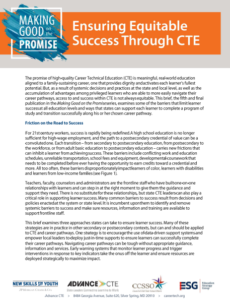 Financial expenses, work commitments, developmental education and healthcare needs are some of the most common barriers to success for community college students, according to a
Financial expenses, work commitments, developmental education and healthcare needs are some of the most common barriers to success for community college students, according to a 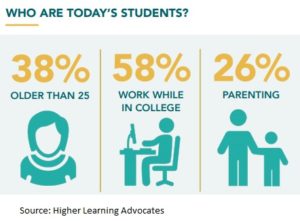 While most people think of the typical college student as coming directly from high school, the reality is that
While most people think of the typical college student as coming directly from high school, the reality is that 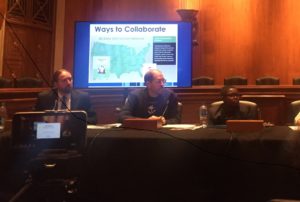 Afterschool programs can give students access to enriching career exploration opportunities outside of the school day, but many of these programs are not accessible to all middle schoolers. Last month, the Senate Career Technical Education (CTE) Caucus, in partnership with the Afterschool Alliance, organized a panel on making the most of middle school career exploration. This panel’s particular focus was the important role that afterschool programs can play in exposing students to career pathways.
Afterschool programs can give students access to enriching career exploration opportunities outside of the school day, but many of these programs are not accessible to all middle schoolers. Last month, the Senate Career Technical Education (CTE) Caucus, in partnership with the Afterschool Alliance, organized a panel on making the most of middle school career exploration. This panel’s particular focus was the important role that afterschool programs can play in exposing students to career pathways.  The Met, a work-based learning focused technical center in Providence, Rhode Island, serves about 800 students across the state. It is also one of eight recipients of
The Met, a work-based learning focused technical center in Providence, Rhode Island, serves about 800 students across the state. It is also one of eight recipients of  Students were hard at work on their laptops when we walked into the 12th grade environmental science class at Oakland High School. They were writing their senior research papers on different environmental issues in their Bay Area community, the culminating project to graduate from the Environmental Science Academy. One student was writing about the the economic impact of a diminishing bee population, another was looking into the effect of recent wildfires in northern California. And they were more than happy to show off their projects.
Students were hard at work on their laptops when we walked into the 12th grade environmental science class at Oakland High School. They were writing their senior research papers on different environmental issues in their Bay Area community, the culminating project to graduate from the Environmental Science Academy. One student was writing about the the economic impact of a diminishing bee population, another was looking into the effect of recent wildfires in northern California. And they were more than happy to show off their projects.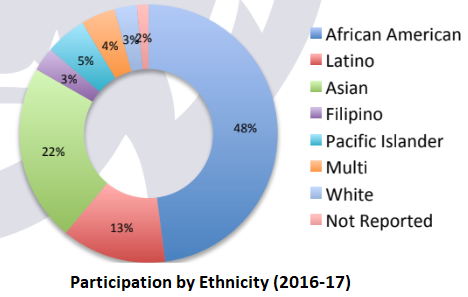 The Linked Learning approach has had a notable impact on O-High student outcomes. In 2018, 81 percent of students graduated and 70 percent enrolled in college within one year. Part of this success is attributable to the high school’s absolute focus on equity. School leaders take special care to ensure that enrollment in each pathway reflects the broader student population, with parity across ethnicity, gender and disability. And in 2010, Oakland Unified launched the Office of African American Male Achievement (AAMA) to support and develop young black males throughout the district. As a result, the African American graduation rate at O-High jumped from 58 percent in 2014 to 90 percent in 2018.
The Linked Learning approach has had a notable impact on O-High student outcomes. In 2018, 81 percent of students graduated and 70 percent enrolled in college within one year. Part of this success is attributable to the high school’s absolute focus on equity. School leaders take special care to ensure that enrollment in each pathway reflects the broader student population, with parity across ethnicity, gender and disability. And in 2010, Oakland Unified launched the Office of African American Male Achievement (AAMA) to support and develop young black males throughout the district. As a result, the African American graduation rate at O-High jumped from 58 percent in 2014 to 90 percent in 2018.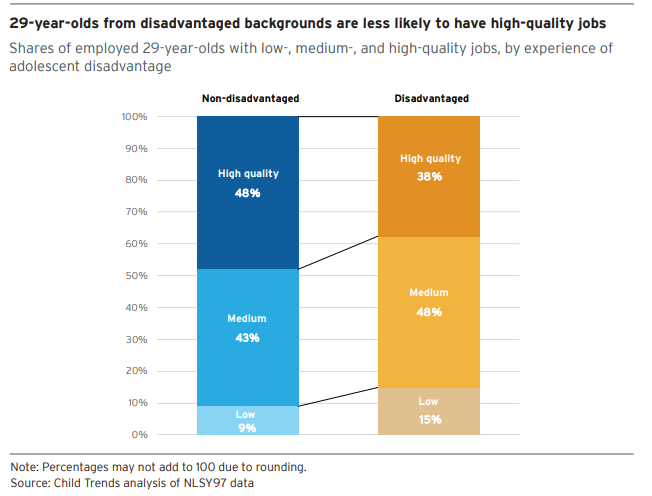 Specifically, the researchers find that participating in “relationship-focused CTE” (a term they use to refer to work-based learning and other activities where students interact with industry mentors) is significantly related to higher job quality scores at age 29. This would seem to suggest that building relationships with industry mentors and completing work-based learning at an early age can help learners, particularly low-income learners, get a leg up on their careers. While the data do not provide a full picture of the quality of work-based learning in the study, the evidence is promising.
Specifically, the researchers find that participating in “relationship-focused CTE” (a term they use to refer to work-based learning and other activities where students interact with industry mentors) is significantly related to higher job quality scores at age 29. This would seem to suggest that building relationships with industry mentors and completing work-based learning at an early age can help learners, particularly low-income learners, get a leg up on their careers. While the data do not provide a full picture of the quality of work-based learning in the study, the evidence is promising.